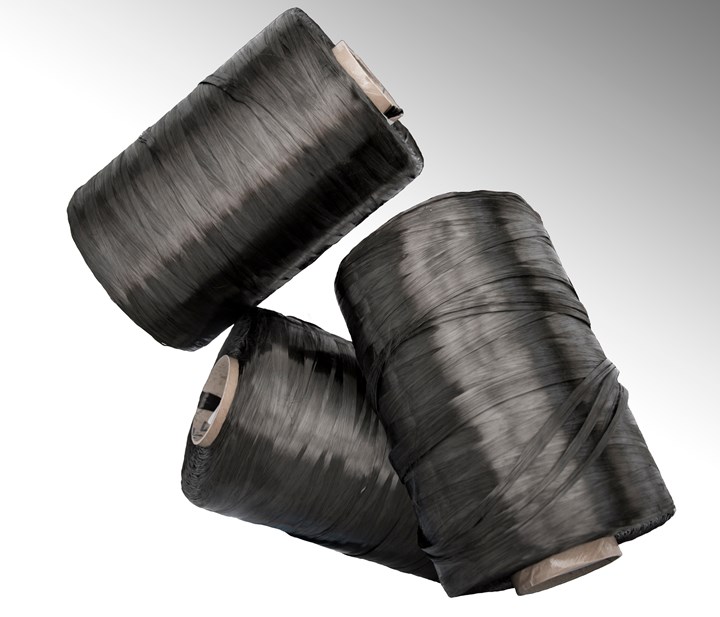"Green" carbon fiber: Renewable energy powers fiber production
Zoltek is first in the industry to use “green” electricity to produce a portion of its heavy-tow carbon fiber.

At its sprawling Nyergesújfalu plant in Hungary, Zoltek Companies Inc. has just started using electricity produced from renewable resources to help produce “green” carbon fiber. With annual production capacity of 15,000 metric tons, the facility is said to be the world’s largest fully integrated carbon fiber plant where polyacrylonitrile (PAN) precursor, carbon fiber itself and downstream, value-added carbon fiber-based intermediates like fabrics and pultruded goods are all produced at a single site. Source | Zoltek
Zoltek Companies Inc. (St. Louis, Missouri, U.S.) is the first carbon fiber producer to use green energy — electricity produced from renewable resources such as wind turbines — to manufacture a portion of its global carbon fiber production.
At the start of the year, Zoltek’s facility in Nyergesújfalu, Hungary began using electricity from renewable resources to power everything from precursor production, to ovens used to carbonize precursor on the way to producing carbon fiber, to intermediate products made from the carbon fiber. “The green electricity is being used for every step of the process, from the moment our raw material enters our facility until the moment the finished carbon fiber leaves as part of a shipment to a customer,” explains Tobias Potyra, Zoltek global automotive director.
This switch in energy sources — at a cost premium that will be borne by Zoltek and not passed on to customers — is estimated to save 5,000 metric tons of carbon dioxide (CO2) annually versus electricity generated by burning coal or natural gas. The plant’s local electricity supplier will issue CO2 certificates to Zoltek based on actual consumption at year’s end.
The significance of this step becomes clearer when the size of the Nyergesújfalu facility it considered. It has an annual capacity of 15,000 metric tons and is said to be the world’s largest fully integrated carbon fiber plant where polyacrylonitrile (PAN) precursor, carbon fiber itself, and downstream, value-added carbon fiber-based intermediates like fabrics and pultruded goods are all produced at a single site. Given how energy-intensive carbon fiber production is, let’s hope that other carbon fiber producers follow suit.

Although it still looks black, a portion of Zoltek’s total global output of industrial-grade (heavy-tow) carbon fiber has just become greener thanks to use of electricity produced from renewable resources that helps offset the greenhouse gases normally generated when electricity is produced by burning coal or natural gas. Source | Török Brigi / BrigiPix Média
Reportedly, the change is being made as part of Zoltek’s internal efforts to focus on sustainability in all areas of its business. “Our carbon fibers enable wind energy to compete with fossil fuels, automobiles to be lighter weight, and batteries to be more efficient, so the shift to renewables to power our own precursor and carbon fiber manufacturing was the next logical step,” explains David Purcell, Zoltek executive vice president. “The proactive use of renewable energy aligns with both our own corporate philosophy as well as the philosophies of many of the industries we serve across the globe whose products already benefit the environment.”
“At Zoltek, we focus every day on ways to make life better for future generations,” adds Nobuya Ando, Zoltek CEO and president. “Using green energy is our responsibility to our customers, our shareholders, and everyone in our communities.”
Zoltek is the global producer of lower-cost, industrial-grade (heavy-tow) carbon fiber and carbon fiber-based intermediates for automotive, wind energy, thermoplastic compounding, offshore drilling, civil engineering, marine and other industrial segments. It was acquired by Toray Group (Tokyo, Japan) in 2014.
Related Content
Prepreg compression molding supports higher-rate propeller manufacturing
To meet increasing UAV market demands, Mejzlik Propellers has added a higher-rate compression molding line to its custom CFRP propeller capabilities.
Read MoreComposite resins price change report
CW’s running summary of resin price change announcements from major material suppliers that serve the composites manufacturing industry.
Read MoreClean Sky 2 outer wing box demonstrator validates OOA LRI, shimless assembly and SHM
Full-scale wing box project achieves TRL 5 with 2% weight reduction and 4% reduction in recurring production costs through improved manufacturing efficiency and assembly processes.
Read MoreFlyber launches U.K. composites manufacturing site for advanced mobility applications
The startup’s design automation and composite material layup and curing technologies target lightweighting for aerospace, UAVs, eVTOL and high-performance mobility platforms.
Read MoreRead Next
Cutting 100 pounds, certification time for the X-59 nose cone
Swift Engineering used HyperX software to remove 100 pounds from 38-foot graphite/epoxy cored nose cone for X-59 supersonic aircraft.
Read MoreNext-gen fan blades: Hybrid twin RTM, printed sensors, laser shock disassembly
MORPHO project demonstrates blade with 20% faster RTM cure cycle, uses AI-based monitoring for improved maintenance/life cycle management and proves laser shock disassembly for recycling.
Read MoreCeramic matrix composites: Faster, cheaper, higher temperature
New players proliferate, increasing CMC materials and manufacturing capacity, novel processes and automation to meet demand for higher part volumes and performance.
Read More.jpg;width=70;height=70;mode=crop)












